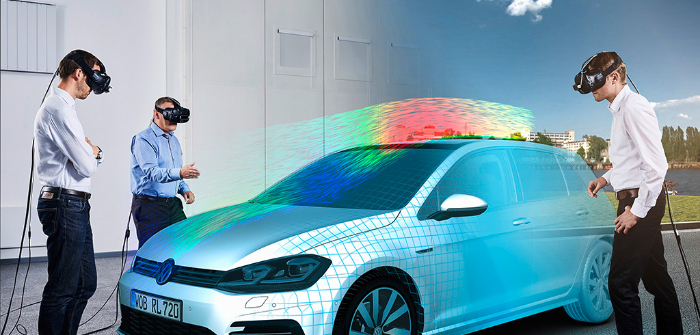ATTI visits Volkwagen’s Virtual Engineering Lab in Wolfsburg, Germany, where augmented reality is enabling vehicle developers to complete more design iterations faster
Bright sunlight floods the Volkswagen Virtual Engineering Lab in Wolfsburg, Germany. In total 24 screens flicker, some of them showing graphics, and others, hundreds of lines of program code. In the center of the room, there is a 1:4 scale model of a Golf. Frank Ostermann inspects the model, then changes its wheels, replaces the rear lights and modifies the wing mirrors. Ostermann uses voice commands and gestures to change the design. This is all completed in a matter of seconds made possible thanks to augmented reality.
The software required was developed in the Virtual Engineering Lab and the team’s results could revolutionize the work of engineers and designers.
Ostermann is wearing HoloLens mixed-reality goggles. The mobile computer developed by Microsoft projects virtual content onto a physical object through gesture control and voice commands. Ostermann only needs to point his finger and the HoloLens projects a different paint color onto the Golf, installs different wheels and modifies the fenders. Initially, the Golf is an R-Line model but it becomes an entirely new version.
Ostermann heads the Virtual Engineering Lab, one of six labs now operated by Volkswagen Group IT in Wolfsburg, Berlin and Munich in Germany, and in San Francisco, California. The latest lab has recently begun operations in Barcelona, Spain. Specialists at these facilities work in close collaboration with research institutions and technology partnerships on new solutions in the fields of big data, Industry 4.0, the Internet of Things, connectivity, mobility services and virtual reality.
“At Volkswagen, we have been using augmented reality and virtual reality for some time, mainly to obtain a three-dimensional view,” says Ostermann. “We are now taking a major step forward at the Virtual Engineering Lab. We are transforming this technology into a tool for technical development. This will enable Volkswagen engineers to work on a virtual vehicle, to change equipment as they wish and to design new components virtually. They will be able to see the results of their work immediately.
“We are cooperating very closely with our colleagues from technical development and are already close to the first new vehicle concepts and design studies,” Ostermann reports. “We contribute our know-how for technical product development and offer tailor-made solutions for all group brands in the fields of virtual engineering and systems engineering.”
Augmented and virtual reality can help save time and development costs. Each step in the process can be made faster and more efficient, for example with HoloLens software from the Virtual Engineering Lab.
The HoloLens not only projects each design or equipment change directly onto the physical model, it also enables several project teams to work at the same time but at different places, for example teams from Wolfsburg, Chattanooga [Tennessee]and Shanghai [China]. All can see the current design model and time-consuming rework, for example on a clay model, could become a thing of the past.
“The teams can directly follow and compare minimal changes to the model and then make a decision. This means that they can reach their goal faster,” Ostermann explains.
Currently, the HoloLens software is still in the trial phase. In future, it will enable users to call up the entire Volkswagen brand model portfolio and to present different body versions of a model in all conceivable variants; the developers will then be able to transform a saloon virtually into an SUV, an estate car, a convertible or a coupe.
“Just a few years ago, this was all science fiction. Now it is clear that this is how we will be developing our next models,” concludes Ostermann.
March 21, 2017


